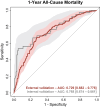Machine learning-based prediction of 1-year all-cause mortality in patients undergoing CRT implantation: validation of the SEMMELWEIS-CRT score in the European CRT Survey I dataset
- PMID: 39318695
- PMCID: PMC11417478
- DOI: 10.1093/ehjdh/ztae051
Machine learning-based prediction of 1-year all-cause mortality in patients undergoing CRT implantation: validation of the SEMMELWEIS-CRT score in the European CRT Survey I dataset
Abstract
Aims: We aimed to externally validate the SEMMELWEIS-CRT score for predicting 1-year all-cause mortality in the European Cardiac Resynchronization Therapy (CRT) Survey I dataset-a large multi-centre cohort of patients undergoing CRT implantation.
Methods and results: The SEMMELWEIS-CRT score is a machine learning-based tool trained for predicting all-cause mortality in patients undergoing CRT implantation. This tool demonstrated impressive performance during internal validation but has not yet been validated externally. To this end, we applied it to the data of 1367 patients from the European CRT Survey I dataset. The SEMMELWEIS-CRT predicted 1-year mortality with an area under the receiver operating characteristic curve (AUC) of 0.729 (0.682-0.776), which concurred with the performance measured during internal validation [AUC: 0.768 (0.674-0.861), P = 0.466]. Moreover, the SEMMELWEIS-CRT score outperformed multiple conventional statistics-based risk scores, and we demonstrated that a higher predicted probability is not only associated with a higher risk of death [odds ratio (OR): 1.081 (1.061-1.101), P < 0.001] but also with an increased risk of hospitalizations for any cause [OR: 1.013 (1.002-1.025), P = 0.020] or for heart failure [OR: 1.033 (1.015-1.052), P < 0.001], a less than 5% improvement in left ventricular ejection fraction [OR: 1.033 (1.021-1.047), P < 0.001], and lack of improvement in New York Heart Association functional class compared with baseline [OR: 1.018 (1.006-1.029), P = 0.003].
Conclusion: In the European CRT Survey I dataset, the SEMMELWEIS-CRT score predicted 1-year all-cause mortality with good discriminatory power, which confirms the generalizability and demonstrates the potential clinical utility of this machine learning-based risk stratification tool.
Keywords: All-cause death; Cardiac resynchronization therapy; Heart failure; Machine learning; Risk stratification.
© The Author(s) 2024. Published by Oxford University Press on behalf of the European Society of Cardiology.
Conflict of interest statement
Conflict of interest: M.T. was a former employee of Argus Cognitive. M.T. has also received consulting fees from CardioSight, outside the submitted work. A.Kosz. has received consulting fees from Medtronic and Biotronik and personal fees from Biotronik, Boehringer Ingelheim, Boston Scientific, AstraZeneca, Bayer, and Novartis, outside the submitted work. A.Kov. has received personal fees from Argus Cognitive and CardioSight, outside the submitted work. L.G. has received lecture fees from Medtronic, Biotronik, Johnson & Johnson Medical, and Abbott, outside the submitted work. C.L. has received research support from the Swedish Heart-Lung Foundation, Swedish Royal Society of Science, Stockholm County Council, consulting fees from AstraZeneca, Roche Diagnostics, speaker honoraria from Novartis, Astra, Bayer, Vifor Pharma, Medtronic, and Impulse Dynamics and has served on advisory boards for AstraZeneca. B.M. has received personal fees from Biotronik, Boehringer Ingelheim, Abbott, AstraZeneca, and Novartis, as well as grants from Medtronic, outside the submitted work. Other authors declare that they have no conflicts of interest regarding this manuscript.
Figures





Similar articles
-
Machine learning-based mortality prediction of patients undergoing cardiac resynchronization therapy: the SEMMELWEIS-CRT score.Eur Heart J. 2020 May 7;41(18):1747-1756. doi: 10.1093/eurheartj/ehz902. Eur Heart J. 2020. PMID: 31923316 Free PMC article.
-
Validation of a simple risk stratification tool for patients implanted with Cardiac Resynchronization Therapy: the VALID-CRT risk score.Eur J Heart Fail. 2015 Jul;17(7):717-24. doi: 10.1002/ejhf.269. Epub 2015 Apr 23. Eur J Heart Fail. 2015. PMID: 25903349
-
Importance of Systematic Right Ventricular Assessment in Cardiac Resynchronization Therapy Candidates: A Machine Learning Approach.J Am Soc Echocardiogr. 2021 May;34(5):494-502. doi: 10.1016/j.echo.2020.12.025. Epub 2021 Jan 7. J Am Soc Echocardiogr. 2021. PMID: 33422667
-
Left bundle branch area pacing for heart failure patients requiring cardiac resynchronization therapy: A meta-analysis.J Cardiovasc Electrophysiol. 2023 Sep;34(9):1933-1943. doi: 10.1111/jce.16013. Epub 2023 Aug 7. J Cardiovasc Electrophysiol. 2023. PMID: 37548113
-
An individual patient meta-analysis of five randomized trials assessing the effects of cardiac resynchronization therapy on morbidity and mortality in patients with symptomatic heart failure.Eur Heart J. 2013 Dec;34(46):3547-56. doi: 10.1093/eurheartj/eht290. Epub 2013 Jul 29. Eur Heart J. 2013. PMID: 23900696 Free PMC article. Review.
References
-
- Cazeau S, Leclercq C, Lavergne T, Walker S, Varma C, Linde C, et al. . Effects of multisite biventricular pacing in patients with heart failure and intraventricular conduction delay. N Engl J Med 2001;344:873–880. - PubMed
-
- Glikson M, Nielsen JC, Kronborg MB, Michowitz Y, Auricchio A, Barbash IM, et al. . 2021 ESC guidelines on cardiac pacing and cardiac resynchronization therapy. Eur Heart J 2021;42:3427–3520. - PubMed
LinkOut - more resources
Full Text Sources
Research Materials
